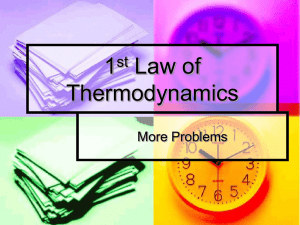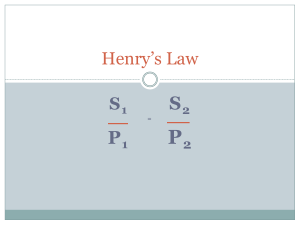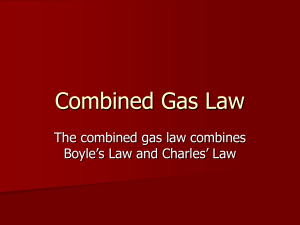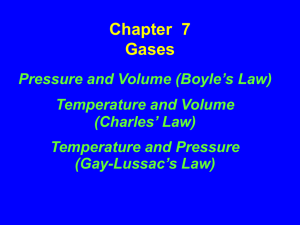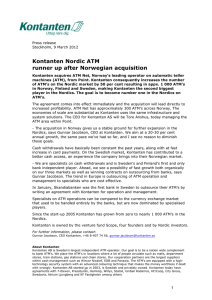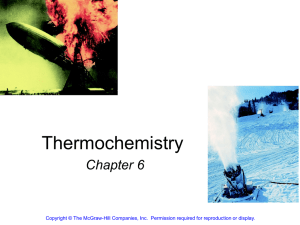Do Now (11/7/13):
advertisement
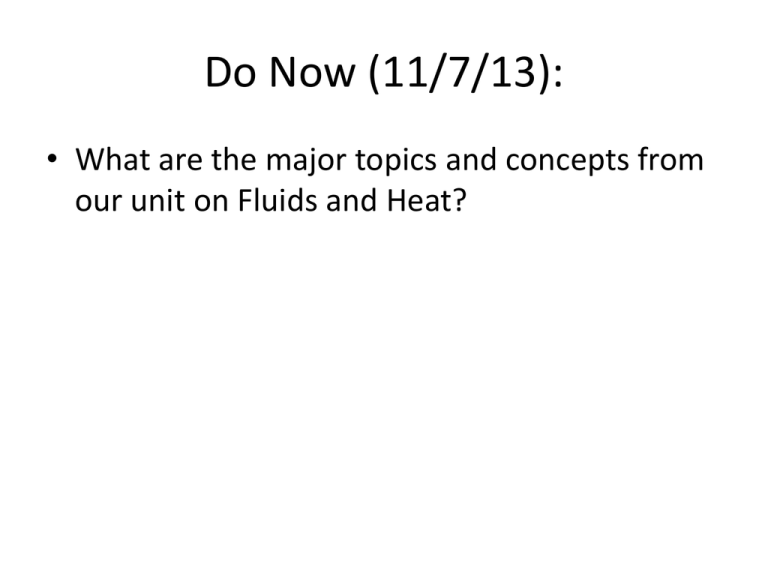
Do Now (11/7/13): • What are the major topics and concepts from our unit on Fluids and Heat? AP Physics Fluids and Thermo Review 11/7/13 AP Guidelines • No calculators during multiple choice • Formula sheets during multiple choice and free response • At bell, multiple choice will be collected and free response will be handed out 1) Which of the following could NOT be used to indicate a temperature change? A change in: A) color of a metal rod B) length of a liquid column C) pressure of a gas at constant volume D) electrical resistance E) mass of one mole of gas at constant pressure 2. One mole of gas is in a closed container of volume Vo and pressure Po. The initial temperature of the gas is T0 The container of gas is heated up to a temperature of 3To. Which of the following statements is (are) true about gas after it has reached this new temperature: I. The pressure of the gas increases to 3Po. II. The kinetic energy of the gas molecules increases by a factor of 3. III. The root mean squared speed of the gas molecules increases by a factor of 3. (A) I only (B) II only (C) I and II only (D) III only (E) I, II, and III 3. At which of the points—A, B, C, or D—is the gas at the greatest temperature? (A) Point A (B) Point B (C) Point C (D) Point D (E) Gas is at the same temperature at all points. 4. In which of the following processes is the gas undergoing a cooling phase? I. AB II. BC III. CD IV. DA (A) II only (B) IV only (C) III and IV (D) II, III, and IV only (E) I only 5. In which process is no work done? I. AB II. BC III. BD (A) I only (B) II only (C) III only (D) I and III only (E) II and III only 6. A sample of gas (assumed to be ideal) is adiabatically compressed to have its volume reduced to 20% of its initial volume. If the internal energy of the gas is increased by 200 J, the work done on the gas must be (a) 40 J (b) 100 J (c) 200 J (d) 400 J (e) zero Answer: 6. Since the process is adiabatic, no heat energy flows from the surroundings to the gas or from the gas to the surroundings. So, the entire work done in compressing the gas is utilised in increasing the internal energy of the gas. The work done on the gas is therefore equal in value to the increase in internal energy, which is C. 200 J. 7. The Greenland ice sheet can be one km thick. Estimate the pressure underneath the ice. (The density of ice is 918 kg/m3.) a. 9.0 × 105 Pa (9 atm) b. 2.5 × 106 Pa (25 atm) c. 4.5 × 106 Pa (45 atm) d. 9.0 × 106 Pa (90 atm) e. 1.2 × 107 Pa (120 atm) 8. Water (density = 1 × 103 kg/m3) flows at 10 m/s through a pipe with radius 0.030 m. The pipe goes up to the second floor of the building, 2.0 m higher, and the pressure remains unchanged. What is the radius of the pipe on the second floor? a. 0.046 m b. 0.034 m c. 0.015 m d. 0.012 m e. 0.010 m 9. In a large tank of liquid, the hydrostatic pressure at a given depth is a function of: a. depth. b. surface area. c. liquid density. d. Choices a and c are both valid. e. Choices a and b are both valid. 10. What volume of water is displaced by a submerged 2.0-kg cylinder made of solid aluminum? (aluminum density = 2.7 × 103 kg/m3 and water density = 1.0 × 103 kg/m3) a. 7.4 × l0−4 m3 b. 1.4 × 103 m3 c. 9.9 × 103 m3 d. 6.0 × 102 m3 e. 4.2 × 102 m3 11. Water is being sprayed from a nozzle at the end of a garden hose of diameter 2.0 cm. If the nozzle has an opening of diameter 0.50 cm, and if the water leaves the nozzle at a speed of 10 m/s, what is the speed of the water inside the hose? a. 0.63 m/s b. 0.80 m/s c. 2.5 m/s d. also 10 m/s e. 12 m/s 12. A fountain sends water to a height of 100 m. What must be the pressurization (above atmospheric) of the underground water system? (1 atm = 105 N/m2) a. 1 atm b. 4.2 atm c. 7.2 atm d. 9.8 atm e. 12 atm 13. A heavily loaded boat is floating in a pond. The boat starts to sink because of a leak but quick action plugging the leak stops the boat from going under although it is now deeper in the water. What happens to the surface level of the pond? a. It stays the same. b. It goes up. c. It goes down. d. More information is needed to reach a conclusion. 14. A large stone is resting on the bottom of the swimming pool. The normal force of the bottom of the pool on the stone is equal to the: a. weight of the stone. b. weight of the water displaced. c. sum of the weight of the stone and the weight of the displaced water. d. difference between the weight of the stone and the weight of the displaced water. e. weight of the water in the swimming pool. Free Response • White Boards Free Response #1 A A small container of gas undergoes a thermodynamic cycle. The gas begins at room temperature. First, the gas expands isobarically until its volume has doubled. Second, the gas expands adiabatically. Third, the gas is cooled isobarically; finally, the gas is compressed adiabatically until it returns to its original state.The initial state of the gas is indicated on the PV diagram below. Sketch this process on the graph. Answer: Free Response #1 B A small container of gas undergoes a thermodynamic cycle. The gas begins at room temperature. First, the gas expands isobarically until its volume has doubled. Second, the gas expands adiabatically. Third, the gas is cooled isobarically; finally, the gas is compressed adiabatically until it returns to its original state. The initial state of the gas is indicated on the PV diagram below. Is the temperature of the gas greater right before or right after the adiabatic expansion? Justify your answer. Answer: The temperature is greater right before the expansion. By definition, in an adiabatic process, no heat is added or removed. But because the gas expanded, work was done by the gas, meaning the W term in the first law of thermodynamics is negative. So, by ΔU = Q + W, Q = 0 and W is negative; so ΔU is negative as well. Internal energy is directly related to temperature. Therefore, because internal energy decreases, so does temperature. Free Response #1 C A small container of gas undergoes a thermodynamic cycle. The gas begins at room temperature. First, the gas expands isobarically until its volume has doubled. Second, the gas expands adiabatically. Third, the gas is cooled isobarically; finally, the gas is compressed adiabatically until it returns to its original state. The initial state of the gas is indicated on the PV diagram below. Is heat added to or removed from the gas in one cycle? Answer: In a full cycle, the gas begins and ends at the same state. So the total change in internal energy is zero. Now consider the total work done on or by the gas. When the gas expands in the first and second process, there's more area under the graph than when the gas compresses in the second and third processes. So, the gas does more work expanding than compressing; the net work is thus done by the gas, and is negative. To get no change in internal energy, the Q term in the first law of thermodynamics must be positive; heat must be added to the gas. Free Response #1 D A small container of gas undergoes a thermodynamic cycle. The gas begins at room temperature. First, the gas expands isobarically until its volume has doubled. Second, the gas expands adiabatically. Third, the gas is cooled isobarically; finally, the gas is compressed adiabatically until it returns to its original state. The initial state of the gas is indicated on the PV diagram below. Does this gas act as a refrigerator or a heat engine? Answer: This is a heat engine. Heat is added to the gas, and net work is done by the gas; that's what a heat engine does. (In a refrigerator, net work is done on the gas, and heat is removed from the gas.) Free Response: Answer the free response sheet with your group. A. a. b. c. d. 240 K 720 K 2160 K 720 K B. • W = 8000 J C. • 29, 900 J D. • Efficiency – 33% Good luck!!!
